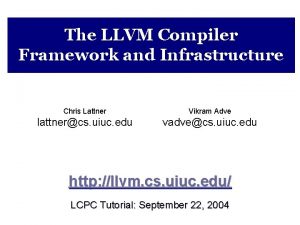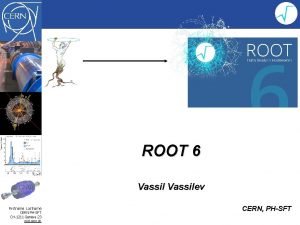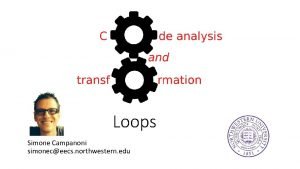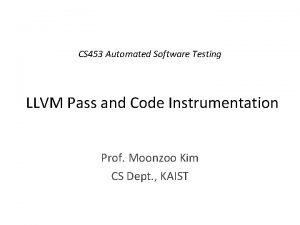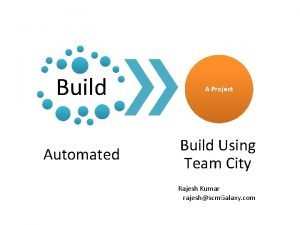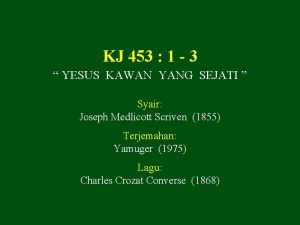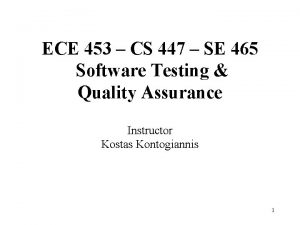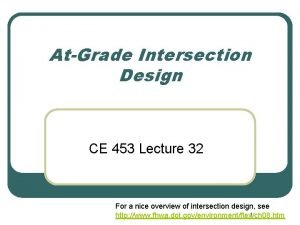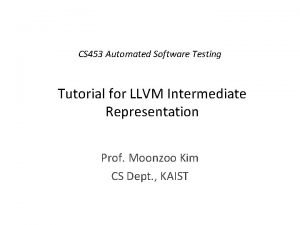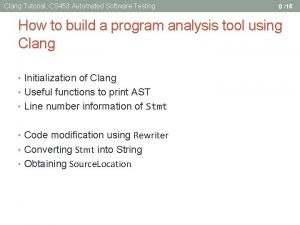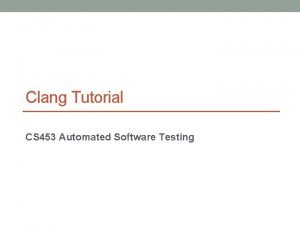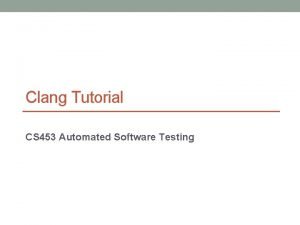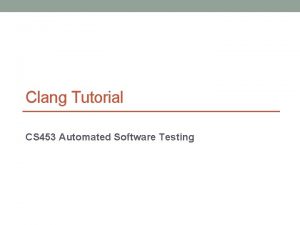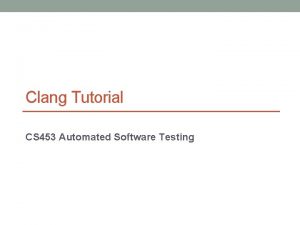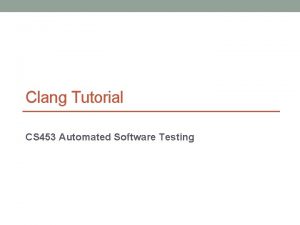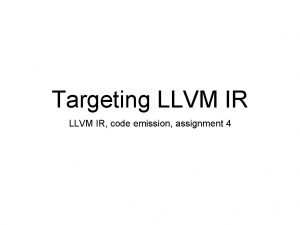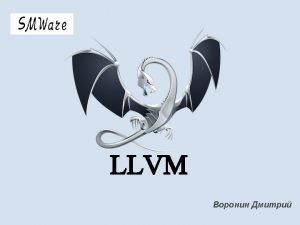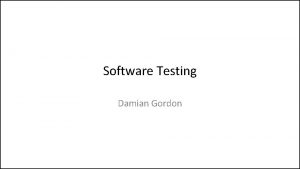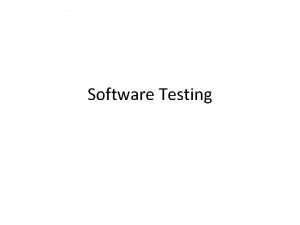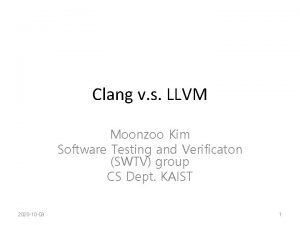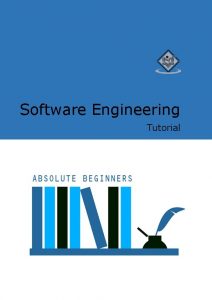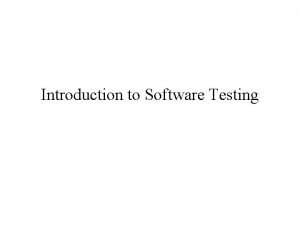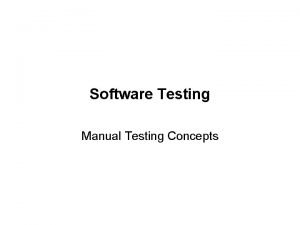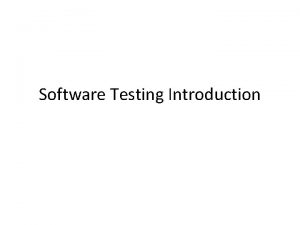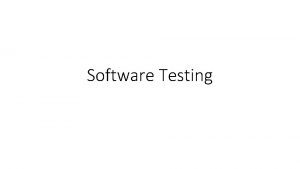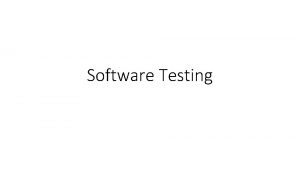CS 453 Automated Software Testing Tutorial for LLVM















![Registers • Identifier syntax – Named registers: [%][a-z. A-Z$. _0 -9]* – Unnamed registers: Registers • Identifier syntax – Named registers: [%][a-z. A-Z$. _0 -9]* – Unnamed registers:](https://slidetodoc.com/presentation_image/4e774e589125d0e6c44711743c6141fb/image-16.jpg)



![Aggregate Types and Function Type • Array: [<# of elements> x <type>] – Single Aggregate Types and Function Type • Array: [<# of elements> x <type>] – Single](https://slidetodoc.com/presentation_image/4e774e589125d0e6c44711743c6141fb/image-20.jpg)







![Add Instruction • <res> = add [nuw][nsw] <i. N> <op 1>, <op 2> – Add Instruction • <res> = add [nuw][nsw] <i. N> <op 1>, <op 2> –](https://slidetodoc.com/presentation_image/4e774e589125d0e6c44711743c6141fb/image-28.jpg)



![Switch • switch <i. N> <value>, label <defaultdest> [<i. N> <val>, label <dest> …] Switch • switch <i. N> <value>, label <defaultdest> [<i. N> <val>, label <dest> …]](https://slidetodoc.com/presentation_image/4e774e589125d0e6c44711743c6141fb/image-32.jpg)
![• <res> = phi <t> [ <val_0>, <label_0>], [ <val_1>, <label_1>], … – • <res> = phi <t> [ <val_0>, <label_0>], [ <val_1>, <label_1>], … –](https://slidetodoc.com/presentation_image/4e774e589125d0e6c44711743c6141fb/image-33.jpg)
![Function Call • <res> = call <t> [<fnty>*] <fnptrval>(<fn args>) – t: the type Function Call • <res> = call <t> [<fnty>*] <fnptrval>(<fn args>) – t: the type](https://slidetodoc.com/presentation_image/4e774e589125d0e6c44711743c6141fb/image-34.jpg)

- Slides: 35

CS 453 Automated Software Testing Tutorial for LLVM Intermediate Representation Prof. Moonzoo Kim CS Dept. , KAIST 2020 -11 -04 / 33

Motivation for Learning LLVM Low-level Language (i. e. , Handling Intermediate Representation) • Biologists know how to analyze laboratory mice. In addition, they know how to modify the mice by applying new medicine or artificial organ • Mechanical engineers know how to analyze and modify mechanical products using CAD tools. • Software engineers also have to know how to analyze and modify software code which is far more complex than any engineering product. Thus, software analysis/modification requires automated analysis tools. – Using source level analysis framework (e. g. , Clang, C Intermediate Language (CIL), EDG parser) – Using low-level intermediate representation (IR) analysis framework (e. g. , LLVM IR) 2020 -11 -04 Tutorial for LLVM Intermediate Representation 2 / 33

LLVM is Professional Compiler • Clang, the LLVM C/C++ front-end supports the full-features of C/C++ and compatible with GCC • The executable compiled by Clang/LLVM is as fast as the executable by GCC 2020 -11 -04 Tutorial for LLVM Intermediate Representation 3 / 33

LLVM Compiler Infrastructure (1/2) • Clang, the LLVM C/C++ front-end supports the full-features of C/C++ and compatible with GCC • The executable compiled by Clang/LLVM is as fast as the executable by GCC / 33

LLVM Compiler Infrastructure (2/2) • A collection of modular compilers and analyzers written in C++ with STL. • LLVM provides 108+ Passes http: //llvm. org/docs/Passes. html – Analyzers (41): alias analysis, call graph constructions, dependence analysis, etc. – Transformers (57): dead code elimination, function inlining, constant propagation, loop unrolling, etc. – Utilities (10): CFG viewer, basic block extractor, etc. C Frontend C C++ Frontend … Object-C 2020 -11 -04 LLVM IR Object-C Frontend … … LLVM Passes … C++ LLVM IR’ 5 / 33

LLVM IR As Analysis Target • The LLVM IR of a program is a better target for analysis and engineering than the program source code. – Language-independent • Able to represent C/C++/Object-C programs – Simple • register machine – Infinite set of typed virtual registers – 3 -address form instruction – Only 31 instruction opcodes • static single assignment (SSA) • composed as basic blocks – Informative • typed language • control-flow • LLVM IR is also called as LLVM language, assembly, bitcode, bytecode, code representation 2020 -11 -04 Tutorial for LLVM Intermediate Representation 6 / 33

LLVM IR At a Glance C program language LLVM IR • Scope: file, function module, function • Type: bool, char, int, struct{int, char} • A statement with multiple expressions i 1, i 8, i 32, {i 32, i 8} • Data-flow: a sequence of reads/writes on variables 1. load the values of memory addresses (variables) to registers; 2. compute the values in registers; 3. store the values of registers to memory addresses * each register must be assigned exactly once (SSA) A sequence of instructions each of which is in a form of “x = y op z”. • Control-flow in a function: A set of basic blocks each of which ends if, for, while, do while, switch-case, … with a conditional jump (or return) 2020 -11 -04 Tutorial for LLVM Intermediate Representation 7 / 33

Example simple. c 1 2 3 4 5 6 7 8 9 10 11 #include <stdio. h> int x, y ; 2 simple. ll (simplified) … 6 @x = common global i 32 0, align 4 7 @y = common global i 32 0, align 4 11 12 … 5 14 … 6 16 4 int main() { int t ; scanf(“%d %d”, &x, &y); t = x – y ; if (t > 0) printf(“x > y”) ; return 0 ; } define i 32 @main() #0 { entry: %t = alloca i 32, align 4 %call = call i 32 (i 8*, . . . )* @__isoc 99_scanf(…i 32* @x, i 32* @y) 7 17 %0 = load i 32* @x, align 4 18 %1 = load i 32* @y, align 4 19 %sub = sub nsw i 32 %0 %1 20 store i 32 %sub, i 32* %t, align 4 8 21 %2 = load i 32* %t, align 4 22 %cmp = icmp sgt i 32 %2, 0 23 br i 1 %cmp, label %if. then, label %if. end 9 24 if. then: $ clang –S –emit-llvm simple. c 25 26 10 27 if. end: 28 2020 -11 -04 %call 1 = call i 32 … @printf(… br label %if. end ret i 32 0 Tutorial for LLVM Intermediate Representation 8 / 33

Contents • LLVM IR Instruction – architecture, static single assignment • Data representation – types, constants, registers, variables – load/store instructions, cast instructions – computational instructions • Control representation – control flow (basic block) – control instructions • How to instrument LLVM IR * LLVM Language Reference Manual http: //llvm. org/docs/Lang. Ref. html * Mapping High-Level Constructs to LLVM IR http: //llvm. lyngvig. org/Articles/Mapping-High-Level-Constructs-to-LLVM-IR 2020 -11 -04 Tutorial for LLVM Intermediate Representation 9 / 33

LLVM IR Architecture • RISC-like instruction set – Only 31 op-codes (types of instructions) exist – Most instructions (e. g. computational instructions) are in three-address form: one or two operands, and one result • Load/store architecture – Memory can be accessed via load/store instruction – Computational instructions operate on registers • Infinite and typed virtual registers – It is possible to declare a new register any point (the backend maps virtual registers to physical ones). – A register is declared with a primitive type (boolean, int, float, pointer) 2020 -11 -04 Tutorial for LLVM Intermediate Representation 10 / 33

Static Single Assignment (1/2) • In SSA, each variable is assigned exactly once, and every variable is defined before its uses. • Conversion – For each definition, create a new version of the target variable (lefthand side) and replace the target variable with the new variable. – For each use, replace the original referred variable with the versioned variable reaching the use point. 1 2 3 4 5 6 2020 -11 -04 x = y y = x if (y x = else x = + + > y x ; y ; 0) ; y + 1 ; 11 12 13 14 15 16 x 1 = y 0 + x 0 ; y 1 = x 1 + y 0 ; if (y 1 > 0) x 2 = y 1 ; else x 3 = y 1 + 1 ; Tutorial for LLVM Intermediate Representation 11 / 33

Static Single Assignment (2/2) • 1 2 3 4 5 6 7 2020 -11 -04 x = y y = x if (y x = else x = y = x + + > y x ; y ; 0) ; y + 1 ; – y ; 11 12 13 14 15 16 17 18 Tutorial for LLVM Intermediate Representation 12 / 33

Data Representations • • Primitive types Constants Registers (virtual registers) Variables – local variables, heap variables, global variables • Load and store instructions • Aggregated types 2020 -11 -04 Tutorial for LLVM Intermediate Representation 13 / 33

Primitive Types • Language independent primitive types with predefined sizes – void: void – bool: i 1 – integers: i[N] where N is 1 to 223 -1 e. g. i 8, i 16, i 32, i 1942652 – floating-point types: half (16 -bit floating point value) float (32 -bit floating point value) double (64 -bit floating point value) • Pointer type is a form of <type>* (e. g. i 32*, (i 32*)*) 2020 -11 -04 Tutorial for LLVM Intermediate Representation 14 / 33

Constants • Boolean (i 1): true and false • Integer: standard integers including negative numbers • Floating point: decimal notation, exponential notation, or hexadecimal notation (IEEE 754 Std. ) • Pointer: null is treated as a special value 2020 -11 -04 Tutorial for LLVM Intermediate Representation 15 / 33
![Registers Identifier syntax Named registers az AZ 0 9 Unnamed registers Registers • Identifier syntax – Named registers: [%][a-z. A-Z$. _0 -9]* – Unnamed registers:](https://slidetodoc.com/presentation_image/4e774e589125d0e6c44711743c6141fb/image-16.jpg)
Registers • Identifier syntax – Named registers: [%][a-z. A-Z$. _0 -9]* – Unnamed registers: [%][0 -9]* • A register has a function-level scope. – Two registers in different functions may have the same identifier • A register is assigned for a particular type and a value at its first (and the only) definition 2020 -11 -04 Tutorial for LLVM Intermediate Representation 16 / 33

Variables • In LLVM, all addressable objects (“lvalues”) are explicitly allocated. • Global variables – Each variable has a global scope symbol that points to the memory address of the object – Variable identifier: [@][a-z. A-Z$. _0 -9]* • Local variables – The alloca instruction allocates memory in the stack frame. – Deallocated automatically if the function returns. • Heap variables – The malloc function call allocates memory on the heap. – The free function call frees the memory allocated by malloc. 2020 -11 -04 Tutorial for LLVM Intermediate Representation 17 / 33

Load and Store Instructions • • Load Store store <type> <value>, <type>* <ptr> <result>=load <type>* <ptr> – result: the target register – type: the type of the data (a pointer type) – ptr: the register that has the address of the data – type: the type of the value – value: either a constant or a register that holds the value – ptr: the register that has the address where the data should be stored Memory CPU Address Var Virtual registers 0 1 x … 99 y 100 2020 -11 -04 load %0 %1 %x %y ALU store 18 / 33

Variable Example 1 2 3 4 5 6 7 8 9 10 #include <stdlib. h> int g = 0 ; int main() { int t = 0; int * p; p=malloc(sizeof(int)); free(p); } 2020 -11 -04 1 @g = global i 32 0, align 4 … 8 define i 32 @main() #0 { … 10 %t = alloca i 32, align 4 11 store i 32 0, i 32* %t, align 4 12 %p = alloca i 32*, align 8 13 %call = call noalias i 8* @malloc(i 64 4) #2 14 %0 = bitcast i 8* %call to i 32* 15 store i 32* %0, i 32** %p, align 8 16 %1 = load i 32** %p, align 8 … Tutorial for LLVM Intermediate Representation 19 / 33
![Aggregate Types and Function Type Array of elements x type Single Aggregate Types and Function Type • Array: [<# of elements> x <type>] – Single](https://slidetodoc.com/presentation_image/4e774e589125d0e6c44711743c6141fb/image-20.jpg)
Aggregate Types and Function Type • Array: [<# of elements> x <type>] – Single dimensional array ex: [40 x i 32], [4 x i 8] – Multi dimensional array ex: [3 x [4 x i 8]], [12 x [10 x float]] • Structure: type {<a list of types>} – E. g. type{ i 32, i 32 }, type{ i 8, i 32 } • Function: <return type> (a list of parameter types) – E. g. i 32 (i 32), float (i 16, i 32*)* 2020 -11 -04 Tutorial for LLVM Intermediate Representation 20 / 33

Getelementptr Instruction • A memory in an aggregate type variable can be accessed by load/store instruction and getelementptr instruction that obtains the pointer to the element. • Syntax: <res> • • • 2020 -11 -04 = getelementptr <pty>* <ptrval>{, <t> <idx>}* res: the target register pty: the register that defines the aggregate type ptrval: the register that points to the data variable t: the type of index idx: the index value Tutorial for LLVM Intermediate Representation 21 / 33

Aggregate Type Example 1 1 2 3 4 struct pair { int first; int second; }; 5 6 7 int main() { int arr[10]; struct pair a; 8 11 %struct. pair = type{ i 32, i 32 } 12 define i 32 @main() { 13 entry: 14 %arr = alloca [10 x i 32] 15 %a = alloca %struct. pair a. first = arr[1]; … 2020 -11 -04 16 %arrayidx = getelementptr [10 x 32]* %arr, i 32 0, i 64 1 17 %0 = load i 32* %arrayidx 18 %first = getelementptr %struct. pair* %a, i 32 0 19 %store i 32 %0, i 32* %first Tutorial for LLVM Intermediate Representation 22 / 33

Aggregate Type Example 2 / 33

Integer Conversion (1/2) • Truncate – Syntax: <res> = trunc <i. N 1> <value> to <i. N 2> where i. N 1 and i. N 2 are of integer type, and N 1 > N 2 – Examples • %X = trunc i 32 257 to i 8 ; %X becomes i 8: 1 • %Y = trunc i 32 123 to i 1 ; %Y becomes i 1: true • %Z = trunc i 32 122 to i 1 ; %Z becomes i 1: false 2020 -11 -04 Tutorial for LLVM Intermediate Representation 24 / 33

Integer Conversion (2/2) • Zero extension – <res> = zext <i. N 1> <value> to <i. N 2> where i. N 1 and i. N 2 are of integer type, and N 1 < N 2 – Fill the remaining bits with zero – Examples • %X = zext i 32 257 to i 64 ; %X becomes i 64: 257 • %Y = zext i 1 true to i 32 ; %Y becomes i 32: 1 • Sign extension – <res> = sext <i. N 1> <value> to <i. N 2> where i. N 1 and i. N 2 are of integer type, and N 1 < N 2 – Fill the remaining bits with the sign bit (the highest order bit) of value – Examples • %X = sext i 8 -1 to i 16 ; %X becomes i 16: 65535 • %Y = sext i 1 true to i 32 ; %Y becomes i 32: 232 -1 2020 -11 -04 Tutorial for LLVM Intermediate Representation 25 / 33

Other Conversions • Float-to-float – fptrunc. . to, fpext. . to • Float-to-integer (vice versa) – fptoui. . to, tptosi. . to, uitofp. . to, sitofp. . to • Pointer-to-integer – ptrtoint. . to, inttoptr. . to • Bitcast – <res> = bitcast <t 1> <value> to <t 2> where t 1 and t 2 should be different types and have the same size 2020 -11 -04 Tutorial for LLVM Intermediate Representation 26 / 33

Computational Instructions • Binary operations: – – Add: add, sub , fsub Multiplication: mul , fmul Division: udiv , sdiv , fdiv Remainder: urem , srem , frem • Bitwise binary operations – shift operations: shl , lshl , ashr – logical operations: and , or , xor 2020 -11 -04 Tutorial for LLVM Intermediate Representation 27 / 33
![Add Instruction res add nuwnsw i N op 1 op 2 Add Instruction • <res> = add [nuw][nsw] <i. N> <op 1>, <op 2> –](https://slidetodoc.com/presentation_image/4e774e589125d0e6c44711743c6141fb/image-28.jpg)
Add Instruction • <res> = add [nuw][nsw] <i. N> <op 1>, <op 2> – nuw (no unsigned wrap): if unsigned overflow occurs, the result value becomes a poison value (undefined) • E. g: add nuw i 8 255, i 8 1 – nsw (no signed wrap): if signed overflow occurs, the result value becomes a poison value • E. g. add nsw i 8 127, i 8 1 2020 -11 -04 Tutorial for LLVM Intermediate Representation 28 / 33

Control Representation • The LLVM front-end constructs the control flow graph (CFG) of every function explicitly in LLVM IR – A function has a set of basic blocks each of which is a sequence of instructions – A function has exactly one entry basic block – Every basic block is ended with exactly one terminator instruction which explicitly specifies its successor basic blocks if there exist. • Terminator instructions: branches (conditional, unconditional), return, unwind, invoke • Due to its simple control flow structure, it is convenient to analyze, transform the target program in LLVM IR 2020 -11 -04 Tutorial for LLVM Intermediate Representation 29 / 33

Label, Return, and Unconditional Branch • A label is located at the start of a basic block – Each basic block is addressed as the start label – A label x is referenced as register %x whose type is label – The label of the entry block of a function is “entry” • Return ret <type> <value> | ret void • Unconditional branch br label <dest> – At the end of a basic block, this instruction makes a transition to the basic block starting with label <dest> – E. g: br label %entry 2020 -11 -04 Tutorial for LLVM Intermediate Representation 30 / 33

Conditional Branch • <res> = icmp <cmp> <ty> <op 1>, <op 2> – Returns either true or false (i 1) based on comparison of two variables (op 1 and op 2) of the same type (ty) – cmp: comparison option eq (equal), ne (not equal), ugt (unsigned greater than), uge (unsigned greater or equal), ult (unsigned less than), ule (unsigned less or equal), sgt (signed greater than), sge (signed greater or equal), slt (signed less than), sle (signed less or equal) • br i 1 <cond>, label <thenbb>, label <elsebb> – Causes the current execution to transfer to the basic block <thenbb> if the value of <cond> is true; to the basic block <elsebb> otherwise. • Example: 1 2 3 if (x > y) return 1 ; return 0 ; 11 12 13 14 %0 = load i 32* %x %1 = load i 32* %y %cmp = icmp sgt i 32 %0, %1 br i 1 %cmp, label %if. then, label %if. end 15 if. then: … 2020 -11 -04 Tutorial for LLVM Intermediate Representation 31 / 33
![Switch switch i N value label defaultdest i N val label dest Switch • switch <i. N> <value>, label <defaultdest> [<i. N> <val>, label <dest> …]](https://slidetodoc.com/presentation_image/4e774e589125d0e6c44711743c6141fb/image-32.jpg)
Switch • switch <i. N> <value>, label <defaultdest> [<i. N> <val>, label <dest> …] – Transfer control flow to one of many possible destinations – If the value is found (val), control flow is transferred to the corresponding destination (dest); or to the default destination (defaultdest) – Examples: 1 2 3 4 5 6 7 8 switch(x) { case 1: break ; case 2: break ; default: break ; } 11 %0 = load i 32* 12 switch i 32 %0, i 32 1, label 13 i 32 2, label 14 %x label %sw. default [ %sw. bb 1] 15 sw. bb: br label %sw. epilog 16 17 sw. bb 1: br label %sw. epilog 18 19 sw. default: br label %sw. epilog 20 21 sw. epilog: … 2020 -11 -04 Tutorial for LLVM Intermediate Representation 32 / 33
![res phi t val0 label0 val1 label1 • <res> = phi <t> [ <val_0>, <label_0>], [ <val_1>, <label_1>], … –](https://slidetodoc.com/presentation_image/4e774e589125d0e6c44711743c6141fb/image-33.jpg)
• <res> = phi <t> [ <val_0>, <label_0>], [ <val_1>, <label_1>], … – Return a value val_i of type t such that the basic block executed right before the current one is of label_i • Example 1 y = (x > 0) ? x : 0 ; 11 %0 = load i 32* %x 12 %c = icmp sgt i 32 %0 0 13 br i 1 %c, label %c. t, %c. f 14 c. t: 15 %1 = load i 32* %x 16 br label %c. end 17 c. f: 18 br label %c. end 19 c. end: 20 %cond = phi i 32 [%1, %c. t], [0, %c. f] 21 store i 32 %cond, i 32* %y 2020 -11 -04 Tutorial for LLVM Intermediate Representation 33 / 33
![Function Call res call t fnty fnptrvalfn args t the type Function Call • <res> = call <t> [<fnty>*] <fnptrval>(<fn args>) – t: the type](https://slidetodoc.com/presentation_image/4e774e589125d0e6c44711743c6141fb/image-34.jpg)
Function Call • <res> = call <t> [<fnty>*] <fnptrval>(<fn args>) – t: the type of the call return value – fnty: the signature of the pointer to the target function (optional) – fnptrval: an LLVM value containing a pointer to a target function – fn args: argument list whose types match the function signature • Examples: 11 @. str = [3 x i 8] c”%d�0” 1 printf(“%d”, abs(x)); 12 %0 = load i 32* %x 13 %call = call i 32 @abs(i 32 %0) 14 %call 1 = call i 32 (i 8*, . . . )* @printf(i 8* getelementptr ([3 x i 8]* @. str, i 32 0), i 32 %call) 2020 -11 -04 Tutorial for LLVM Intermediate Representation 34 / 33

Unaddressed Issues • Many options/attributes of instructions • Vector data type (SIMD style) • Exception handling • Object-oriented programming specific features • Concurrency issues – Memory model, synchronization, atomic instructions * http: //llvm. org/docs/Lang. Ref. html 2020 -11 -04 Tutorial for LLVM Intermediate Representation 35 / 33
 Llvm chris lattner
Llvm chris lattner Llvm
Llvm Euro llvm
Euro llvm Vplans
Vplans Llvm functioncallee
Llvm functioncallee Llvm
Llvm Domain testing in software testing
Domain testing in software testing Motivational overview of logic based testing
Motivational overview of logic based testing Du path testing
Du path testing Globalization testing in software testing
Globalization testing in software testing Cause effect graph for triangle problem
Cause effect graph for triangle problem Control structure testing in software testing
Control structure testing in software testing Decision table testing in software testing
Decision table testing in software testing Decision table for triangle problem
Decision table for triangle problem Decision table testing
Decision table testing Rigorous testing in software testing
Rigorous testing in software testing Testing blindness in software testing
Testing blindness in software testing Domain example
Domain example Sglib1
Sglib1 Sitecore automated testing
Sitecore automated testing Creating an automated testing framework with selenium
Creating an automated testing framework with selenium Which process requires automated builds and testing
Which process requires automated builds and testing Sap solution manager test automation
Sap solution manager test automation Automated whitebox fuzz testing
Automated whitebox fuzz testing Automated whitebox fuzz testing
Automated whitebox fuzz testing Automated commercial environment software
Automated commercial environment software Software for automated commercial environment
Software for automated commercial environment Automated grading software
Automated grading software 65 in 40 ı kaçtır
65 in 40 ı kaçtır Nrs 453
Nrs 453 Kj 453 lirik
Kj 453 lirik Ece 453
Ece 453 300'e yuvarlanan en küçük sayı
300'e yuvarlanan en küçük sayı Ce453
Ce453 Weerklank 453
Weerklank 453 Mbg453
Mbg453
